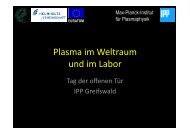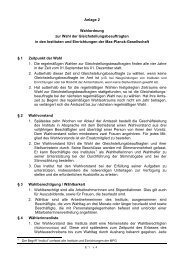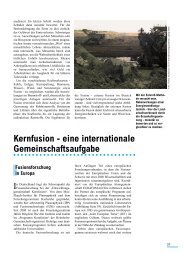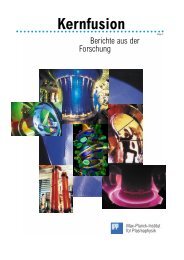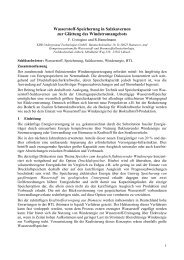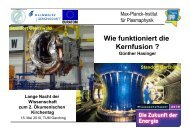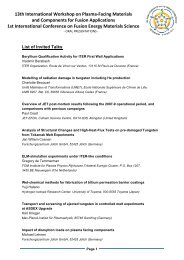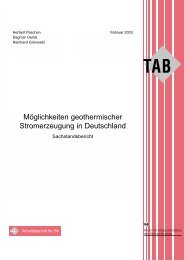IPP Annual Report 2007 - Max-Planck-Institut für Plasmaphysik ...
IPP Annual Report 2007 - Max-Planck-Institut für Plasmaphysik ...
IPP Annual Report 2007 - Max-Planck-Institut für Plasmaphysik ...
Create successful ePaper yourself
Turn your PDF publications into a flip-book with our unique Google optimized e-Paper software.
the future, a new safety interlock was introduced which<br />
switches off the RF system in case of an unrequested power<br />
output. Whenever the limited time between shots allowed,<br />
conditioning of source no. 2 was continued. This source had<br />
been installed close to the end of the previous campaign as a<br />
replacement for a source which had suffered a water leak.<br />
At the beginning of the <strong>2007</strong> campaign, the source’s extraction<br />
grid system was in a completely unconditioned state.<br />
After about 1300 conditioning shots at the end of the campaign<br />
the source could be operated more or less reliably at<br />
40 kV, where 60 kV is the standard operation voltage of this<br />
injector. Conditioning is expected to be finished during the<br />
2008 campaign.<br />
In the following two months shutdown phase maintenance<br />
of both injectors could be finished in due time for the start of<br />
the next campaign despite an extensive list of tasks. Among<br />
them, all eight titanium evaporator pumps were overhauled.<br />
Traces of melting were discovered on bellows of the cooling<br />
connections to the ion dumps of the second injector. The<br />
bellows were replaced and protection shields installed.<br />
3.5 Ion Cyclotron heating<br />
The ICRF system was ready when ASDEX Upgrade restarted<br />
operation. Now all antennas are equipped with W-coated<br />
limiters. One antenna has an optically closed Faraday<br />
screen, to investigate the influence of shielding the antenna<br />
from plasma, possibly expelled by ELMs into the antenna,<br />
on its voltage standoff capability. One antenna has also been<br />
fitted with the option to locally inject gas and with diagnostics<br />
to measure currents drawn by some limiters. Whereas<br />
experimentation with ICRF has become more difficult, a way<br />
was found to still use ICRF efficiently to heat high density<br />
discharges centrally: a large plasma-antenna distance is beneficial,<br />
together with a high gas puff rate. In terms of plasma<br />
and impurity behaviour, there is no difference between<br />
standard gas puff and local gas puff near the antenna. The<br />
latter however has the advantage that it increases the antenna<br />
coupling resistance, which is low at a large antennaplasma<br />
distance.<br />
One of the power tetrodes failed during operation, increasing<br />
the need to find a solution for the unavailability of replacement<br />
tetrodes. While this tetrode is being refurbished, the<br />
ICRF systems have to operate without any spare tetrode.<br />
The failure of another tetrode would result in a reduction of<br />
the available power by half. The option to modify the generators<br />
to be able to use commercially available tetrodes is<br />
being investigated.<br />
During the AUG vessel opening at the end of the year, diagonal<br />
plates covering the uncompensated top and bottom<br />
parts of the antenna straps have been installed. Calculations<br />
show that the dominant contributions to the electric fields are<br />
due to currents in the antenna box. Consequently, this installation<br />
should not lead to a substantial change in impurity<br />
ASDEX Upgrade<br />
10<br />
production, as long as the fields due to the antenna box<br />
remain the major contribution. Our modelling also shows<br />
that those dominant fields can be reduced, by placing the<br />
antenna in a wall and by having 4 straps with the proper<br />
phasing, rather than 2. A new vacuum chamber, where such<br />
a 4-strap antenna can be tested, was ordered for the new test<br />
facility located in the L7 hall. The contract for the automatic<br />
matching was cancelled as it became clear that the company<br />
that had been working on it since 2000 could not fulfil its<br />
obligations. Alternative options are being investigated. A<br />
complete overhaul of the compressor system providing pressurized<br />
air for the transmission lines is ongoing. It will allow<br />
for faster refilling of those lines and easier maintenance.<br />
3.6 Electron Cyclotron Resonance Heating<br />
In <strong>2007</strong> both ECRH systems were routinely requested for a<br />
large number of ASDEX Upgrade pulses. The main drive<br />
for the use of ECRH was the prevention of central accumulation<br />
of tungsten (see section 2). The old system was back<br />
to full power (i.e. 1.6 MW, 2 s or 0.8 MW, 4 s) after a gyrotron<br />
broken in 2004 was replaced in the last shutdown by a<br />
similar tube, formerly used at W7-AS.<br />
In February <strong>2007</strong> the new 2-frequency gyrotron Odissey-2<br />
was commissioned. The achieved maximum output power<br />
was 910 kW at 140 GHz and 650 kW at 105 GHz, both for<br />
10 s. Using the new gyrotron, the new stainless-steel highpower<br />
long-pulse load from GYCOM has been conditioned<br />
rapidly and has operated very reliably since then. With<br />
140 GHz the gyrotron was used routinely for heating (700 kW,<br />
limited by arcing in torus-side mirror box, for 5 s, limited by<br />
plasma duration). With 105 GHz, first experiments for collective<br />
Thomson Scattering were performed with the new<br />
RisØ-System which receives its signal through the transmission<br />
line of unit 2. The extension of the new ECRH-2 system<br />
with three 4-frequency gyrotrons 105-140 GHz/4×1 MW/10 sec<br />
is ongoing. First short-pulse tests of the modified gyrotron<br />
Odissey-1, which has been equipped with a BN-Brewster<br />
window, were performed at GYCOM up to 1 MW/0.8 MW<br />
at 140 GHz/other frequencies. No arcing on the air-side was<br />
observed, proving the viability of the concept. Actually the<br />
BN-window has been replaced by a diamond window. Final<br />
factory tests are expected soon. For details on the future<br />
planning for the new system see section 4.<br />
4 AUG enhancements<br />
Continuous progress in tokamak research needs hardware<br />
upgrades that enhance the machine’s capabilities into new<br />
directions, according to recent theoretical and experimental<br />
findings. In line with its mission to prepare for ITER,<br />
ASDEX Upgrade is presently being equipped with new<br />
tools that will enable active control of MHD modes both in<br />
the plasma core (sawteeth, NTMs) as well as in the edge




